%%capture
!pip install kornia
!pip install kornia-rs
!pip install kornia_moons
!pip install opencv-python --upgradeImage matching example with kornia local features: TFeat, MKD, OriNet, HyNet and OpenCV detector
It is possible to use OpenCV local features, such as SIFT with kornia via kornia_moons library.
First, we will install everything needed:
- fresh version of kornia for MKD and TFeat descriptors
- fresh version of OpenCV for SIFT features and MAGSAC++
- kornia_moons for the conversions between OpenCV and kornia formats
Now let’s download an image pair
import io
import requests
def download_image(url: str, filename: str = "") -> str:
filename = url.split("/")[-1] if len(filename) == 0 else filename
# Download
bytesio = io.BytesIO(requests.get(url).content)
# Save file
with open(filename, "wb") as outfile:
outfile.write(bytesio.getbuffer())
return filename
url_a = "https://github.com/kornia/data/raw/main/matching/kn_church-2.jpg"
url_b = "https://github.com/kornia/data/raw/main/matching/kn_church-8.jpg"
download_image(url_a)
download_image(url_b)'kn_church-8.jpg'First, we will define image matching pipeline with OpenCV SIFT features. We will also use kornia for the state-of-the-art match filtering – Lowe ratio + mutual nearest neighbor check.
Imports
import cv2
import kornia as K
import kornia.feature as KF
import matplotlib.pyplot as plt
import numpy as np
import torch
from kornia_moons.feature import *
from kornia_moons.viz import *Using OpenCV SIFT as is and converting it manually
def sift_matching(fname1, fname2):
img1 = cv2.cvtColor(cv2.imread(fname1), cv2.COLOR_BGR2RGB)
print(img1.shape)
img2 = cv2.cvtColor(cv2.imread(fname2), cv2.COLOR_BGR2RGB)
# OpenCV SIFT
sift = cv2.SIFT_create(8000)
kps1, descs1 = sift.detectAndCompute(img1, None)
kps2, descs2 = sift.detectAndCompute(img2, None)
# Converting to kornia for matching via AdaLAM
lafs1 = laf_from_opencv_SIFT_kpts(kps1)
lafs2 = laf_from_opencv_SIFT_kpts(kps2)
dists, idxs = KF.match_adalam(
torch.from_numpy(descs1), torch.from_numpy(descs2), lafs1, lafs2, hw1=img1.shape[:2], hw2=img2.shape[:2]
)
# Converting back to kornia via to use OpenCV MAGSAC++
tentatives = cv2_matches_from_kornia(dists, idxs)
src_pts = np.float32([kps1[m.queryIdx].pt for m in tentatives]).reshape(-1, 2)
dst_pts = np.float32([kps2[m.trainIdx].pt for m in tentatives]).reshape(-1, 2)
F, inliers_mask = cv2.findFundamentalMat(src_pts, dst_pts, cv2.USAC_MAGSAC, 0.25, 0.999, 100000)
# Drawing matches using kornia_moons
draw_LAF_matches(
lafs1,
lafs2,
idxs,
img1,
img2,
inliers_mask.astype(bool).reshape(-1),
draw_dict={"inlier_color": (0.2, 1, 0.2), "tentative_color": None, "feature_color": None, "vertical": False},
)
print(f"{inliers_mask.sum()} inliers found")
returnfname1 = "kn_church-2.jpg"
fname2 = "kn_church-8.jpg"
sift_matching(fname1, fname2)11 inliers found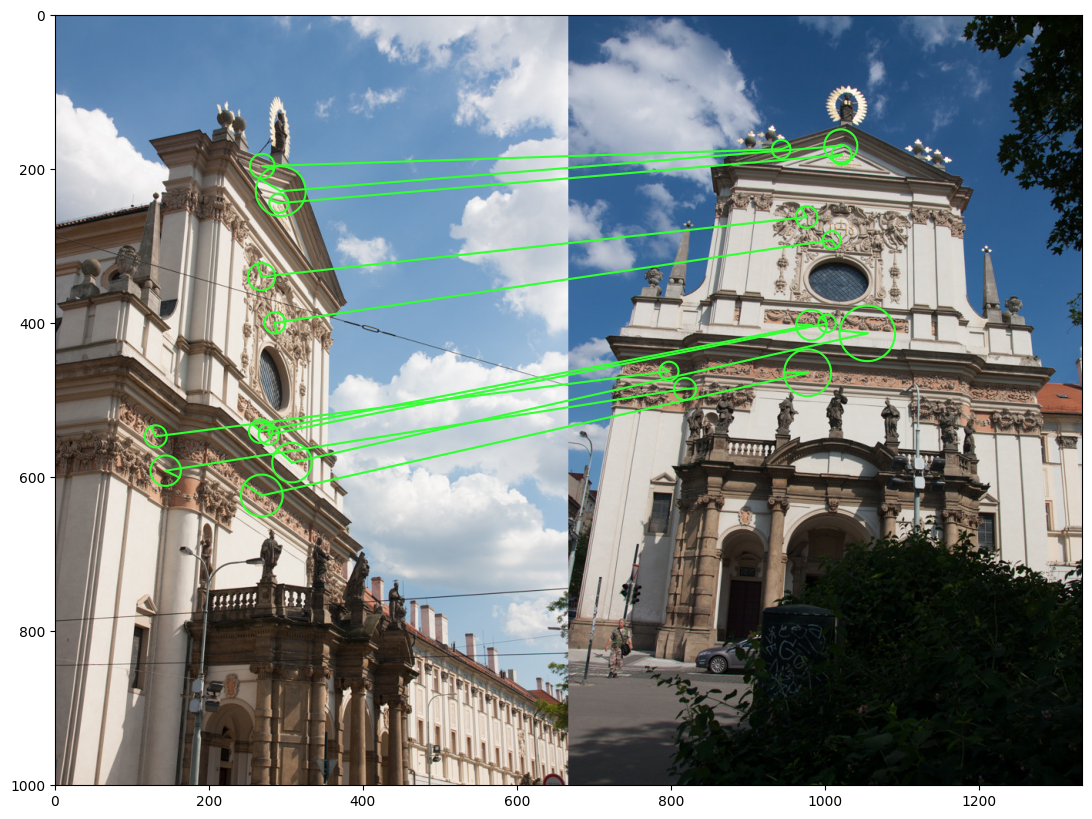
Using OpenCV SIFT with kornia matcher
Now we need to define a function to feed the OpenCV keypoints into local descriptors from kornia. Luckily, that is easy with the help of kornia_moons.
def get_matching_kpts(lafs1, lafs2, idxs):
src_pts = KF.get_laf_center(lafs1).view(-1, 2)[idxs[:, 0]].detach().cpu().numpy()
dst_pts = KF.get_laf_center(lafs2).view(-1, 2)[idxs[:, 1]].detach().cpu().numpy()
return src_pts, dst_pts
def sift_korniadesc_matching(fname1, fname2, descriptor):
timg1 = K.io.load_image(fname1, K.io.ImageLoadType.RGB32)[None, ...] # BxCxHxW
timg2 = K.io.load_image(fname2, K.io.ImageLoadType.RGB32)[None, ...] # BxCxHxW
sift = OpenCVDetectorKornia(cv2.SIFT_create(8000))
local_feature = KF.LocalFeature(sift, KF.LAFDescriptor(descriptor))
lafs1, resps1, descs1 = local_feature(K.color.rgb_to_grayscale(timg1))
lafs2, resps2, descs2 = local_feature(K.color.rgb_to_grayscale(timg2))
dists, idxs = KF.match_adalam(descs1[0], descs2[0], lafs1, lafs2, hw1=timg1.shape[2:], hw2=timg2.shape[2:])
src_pts, dst_pts = get_matching_kpts(lafs1, lafs2, idxs)
F, inliers_mask = cv2.findFundamentalMat(src_pts, dst_pts, cv2.USAC_MAGSAC, 0.25, 0.999, 100000)
draw_LAF_matches(
lafs1,
lafs2,
idxs,
K.tensor_to_image(timg1),
K.tensor_to_image(timg2),
inliers_mask.astype(bool),
draw_dict={"inlier_color": (0.2, 1, 0.2), "tentative_color": None, "feature_color": None, "vertical": False},
)
print(f"{inliers_mask.sum()} inliers found")Now let’s try kornia new descriptors – MKD and TFeat. MKD is one of the best handcrafted local feature descriptors, presented in IJCV 2018 paper “Understanding and Improving Kernel Local Descriptors”.
mkd = KF.MKDDescriptor(32)
with torch.inference_mode():
sift_korniadesc_matching(fname1, fname2, mkd)12 inliers found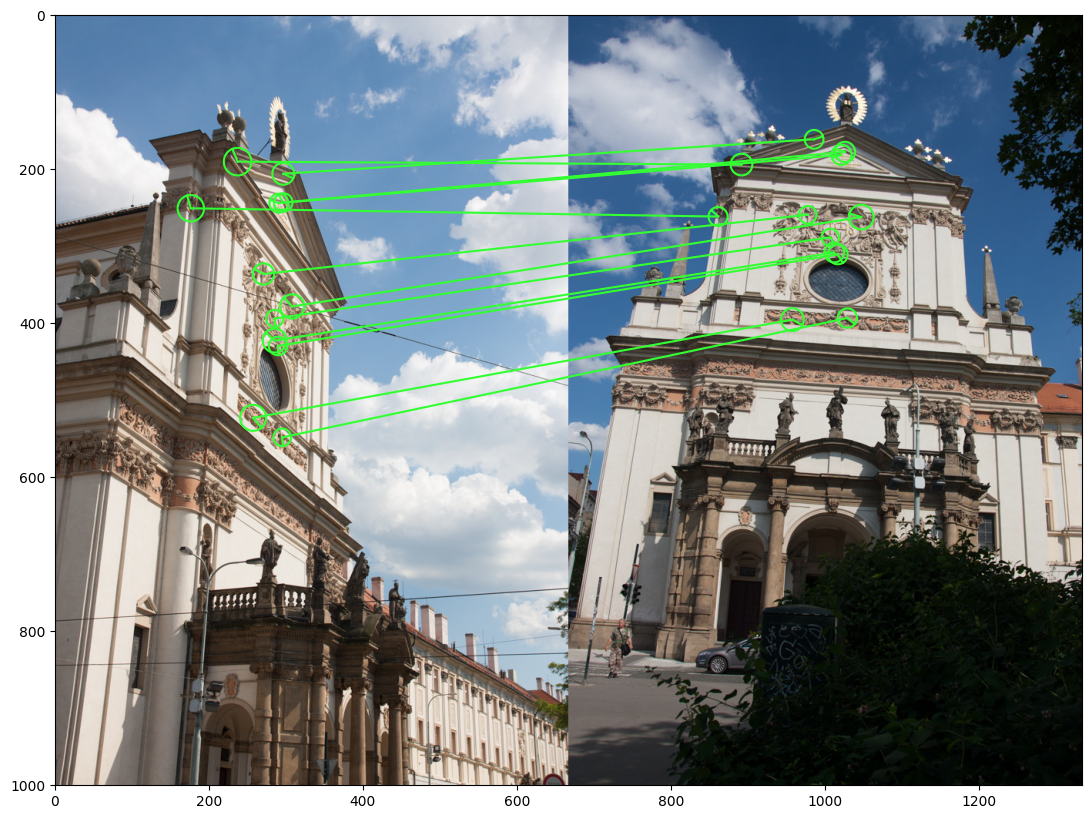
Result seems 2 inliers better than with SIFTs. Let’s try TFeat - lightweight deep learning-based descriptor from BMVC 2016 paper “Learning local feature descriptors with triplets and shallow convolutional neural networks”
tfeat = KF.TFeat(True)
with torch.inference_mode():
sift_korniadesc_matching(fname1, fname2, tfeat)22 inliers found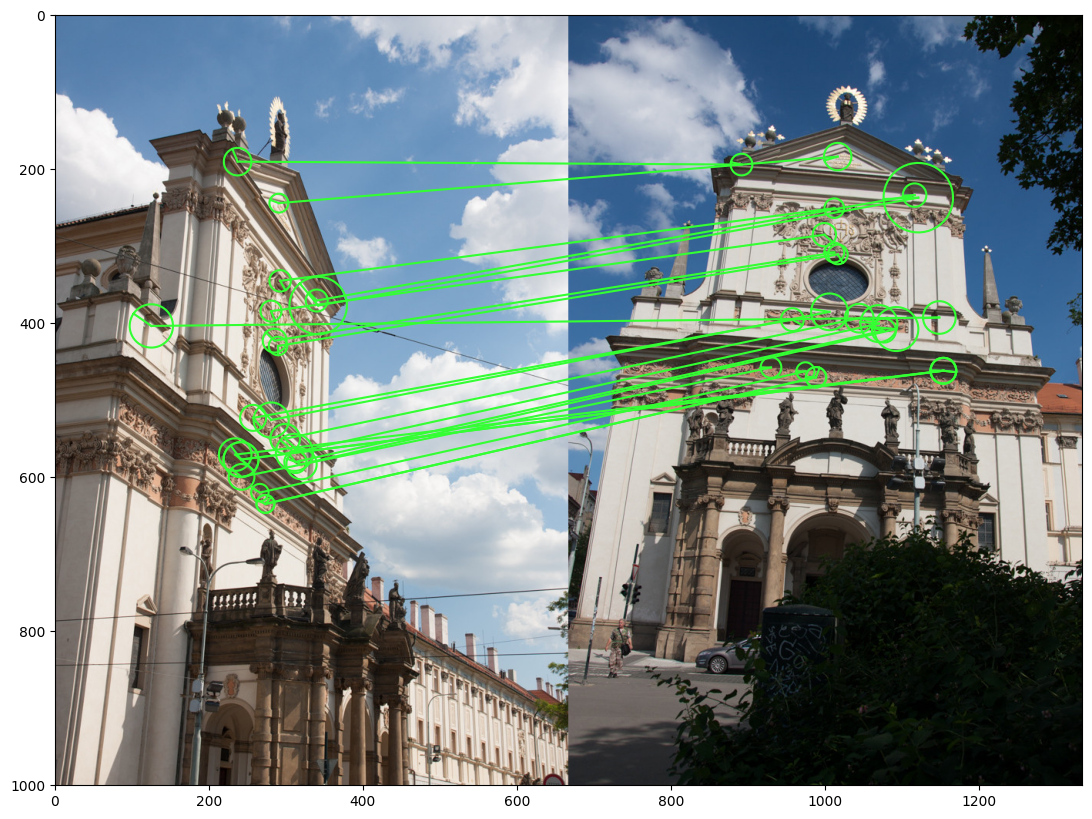
Good old HardNet
In the worst-case we can always fall back to the HardNet – more robust, but also slower than TFeat and MKD, descriptor
device = torch.device("cpu")
hardnet = KF.HardNet(True).eval()
with torch.inference_mode():
sift_korniadesc_matching(fname1, fname2, hardnet)26 inliers found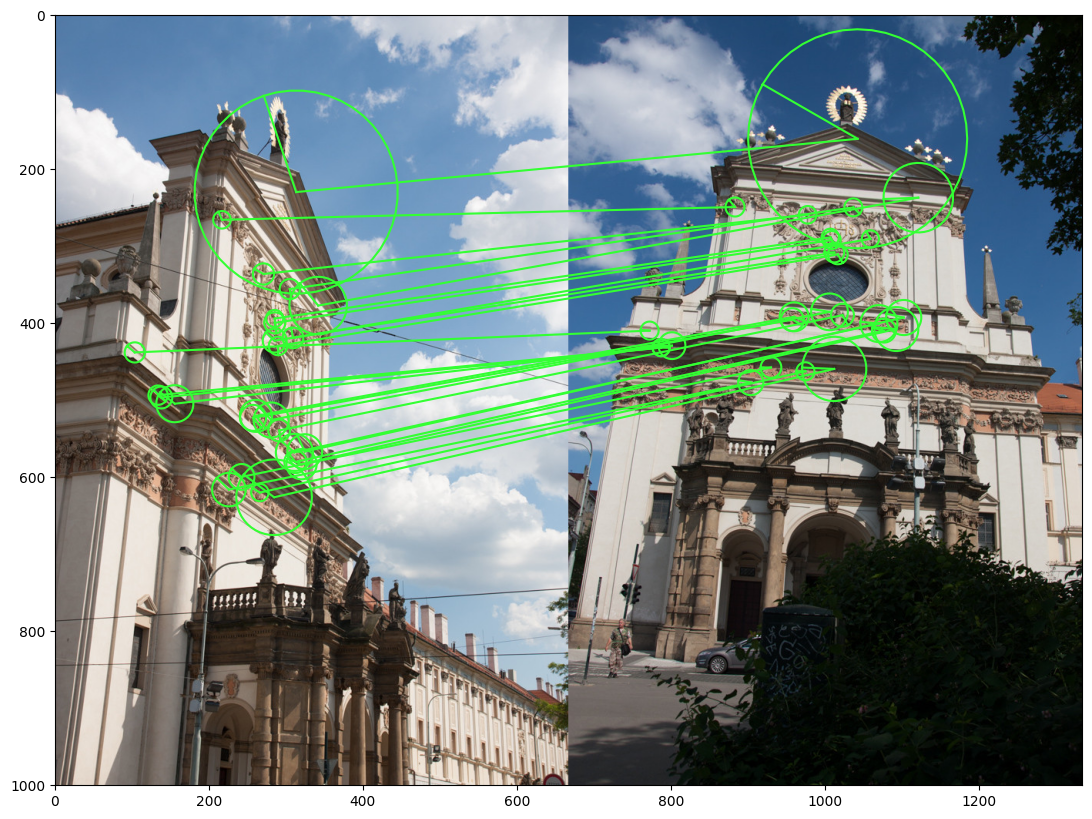
AffNet
We haven’t done yet! SIFT detector is a great tool, but we can improve it by using deep learned affine shape estimation – AffNet. You can do it, using a single function wrapper - OpenCVDetectorWithAffNetKornia.
def siftaffnet_korniadesc_matching(fname1, fname2, descriptor):
timg1 = K.io.load_image(fname1, K.io.ImageLoadType.RGB32)[None, ...] # BxCxHxW
timg2 = K.io.load_image(fname2, K.io.ImageLoadType.RGB32)[None, ...] # BxCxHxW
# Magic is here
sift = OpenCVDetectorWithAffNetKornia(cv2.SIFT_create(8000))
local_feature = KF.LocalFeature(sift, KF.LAFDescriptor(descriptor))
with torch.inference_mode():
lafs1, resps1, descs1 = local_feature(K.color.rgb_to_grayscale(timg1))
lafs2, resps2, descs2 = local_feature(K.color.rgb_to_grayscale(timg2))
dists, idxs = KF.match_adalam(descs1[0], descs2[0], lafs1, lafs2, hw1=timg1.shape[2:], hw2=timg2.shape[2:])
src_pts, dst_pts = get_matching_kpts(lafs1, lafs2, idxs)
F, inliers_mask = cv2.findFundamentalMat(src_pts, dst_pts, cv2.USAC_MAGSAC, 0.25, 0.999, 100000)
draw_LAF_matches(
lafs1,
lafs2,
idxs,
K.tensor_to_image(timg1),
K.tensor_to_image(timg2),
inliers_mask.astype(bool),
draw_dict={"inlier_color": (0.2, 1, 0.2), "tentative_color": None, "feature_color": None, "vertical": False},
)
print(f"{inliers_mask.sum()} inliers found")siftaffnet_korniadesc_matching(fname1, fname2, hardnet)39 inliers found
HyNet
siftaffnet_korniadesc_matching(fname1, fname2, KF.HyNet(True).eval())47 inliers found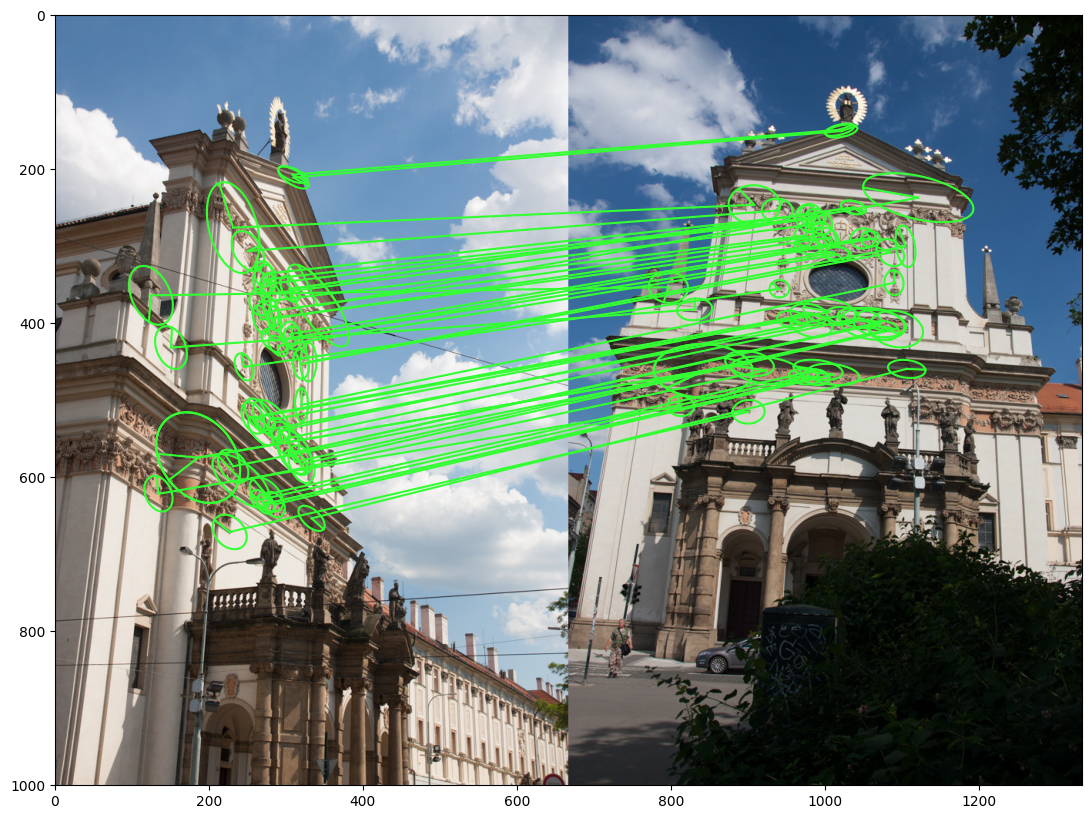
SOSNet
siftaffnet_korniadesc_matching(fname1, fname2, KF.SOSNet(True).eval())48 inliers found
HardNet8
siftaffnet_korniadesc_matching(fname1, fname2, KF.HardNet8(True).eval())38 inliers found